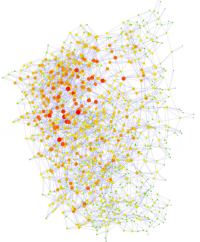Computational study sheds light on how early metabolism might have evolved

The way in which biological cells convert food into energy stored in molecules such as ATP is shared by almost all living things - now scientists have discovered a likely reason why this is so widespread.
In a paper that appeared in Nature Communications last week, Steve Court, Bartek Waclaw, and Rosalind Allen from the School of Physics & Astronomy examined how glucose - a simple sugar - is metabolised by cells in a series of chemical reactions. This process is almost the same for every kind of cell, including animals, plants, and bacteria.
Their research shows that although many alternative pathways exist, the real pathway called glycolysis is the most effective method to produce ATP from glucose. This method might have been selected by biological evolution because cells that have more energy can grow and renew faster, giving them - and the organism to which they belong - an evolutionary advantage.
To construct possible metabolic pathways alternative to glycolysis, Court et al. used a computer program to generate a network of all possible chemical compounds and reactions within a certain class of molecules. The researchers then analysed all possible alternatives to the established biological mechanism, and calculated the rate at which each of them produced ATP. The real glycolysis, and its reverse pathway gluconeogenesis, turned out to be the best pathways for a wide range of cellular conditions.
Nature Communications paper: Lower glycolysis carries a higher flux than any biochemically possible alternative
The study was supported by the Carnegie Trust, Leverhulme Trust, Royal Society, and the Royal Society of Edinburgh.
“The key mechanisms that underpin metabolism are found in almost all plants and animals, and control the productivity of life on Earth, yet we understand little of how they came about. This study shows that our metabolic pathway is a highly developed solution to the problem of how to extract energy from our food.” Dr Bartomiej Waclaw, School of Physics & Astronomy, who took part in the study.

